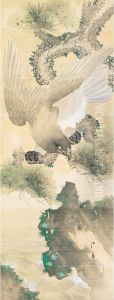Fukui Kotei Paintings
Fukui Kotei was a prominent Japanese artist known for his contributions to the world of Japanese painting, particularly within the Nihonga style, a term that categorizes traditional Japanese painting techniques and subjects. Born in 1871 in Tokyo, Kotei grew up during a time of significant cultural and political change in Japan, as the country was rapidly modernizing and opening up to Western influences following the Meiji Restoration. Despite the influx of Western art forms and techniques, Kotei remained deeply rooted in the traditional Japanese aesthetic and techniques, which would come to define his artistic career.
Kotei's education and training in art were grounded in the rigorous study of classical Japanese painting techniques and the use of traditional materials such as silk, paper, and mineral pigments. He studied under several masters of the Nihonga style, which sought to both preserve and modernize traditional Japanese artistic practices in the face of Westernization. Kotei's works often depicted historical themes, landscapes, and figures from Japanese literature and folklore, characterized by their delicate brushwork, refined composition, and a profound sense of tranquility and beauty.
Throughout his career, Fukui Kotei gained recognition for his mastery of Nihonga painting, contributing significantly to the genre's development and popularity during the late 19th and early 20th centuries. His works were exhibited in numerous art exhibitions, both in Japan and internationally, helping to promote Japanese art and culture worldwide. Kotei's dedication to the traditional arts did not wane even as modern and Western styles became more prevalent in Japan. Instead, he continued to explore and innovate within the Nihonga style, leaving a lasting legacy on the Japanese art scene.
Fukui Kotei passed away in 1944, leaving behind a body of work that continues to be celebrated for its beauty, technical proficiency, and embodiment of traditional Japanese aesthetics. His contributions to the Nihonga style have inspired countless artists and have played a crucial role in the ongoing dialogue between traditional and modern art forms in Japan. Kotei's life and work remain a testament to the enduring appeal and relevance of traditional Japanese painting in a rapidly changing world.
